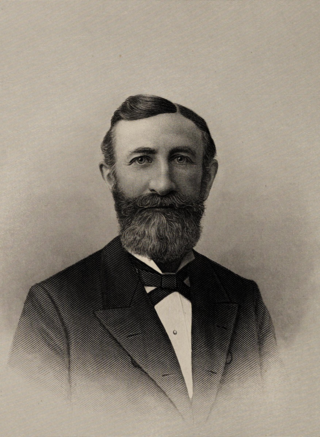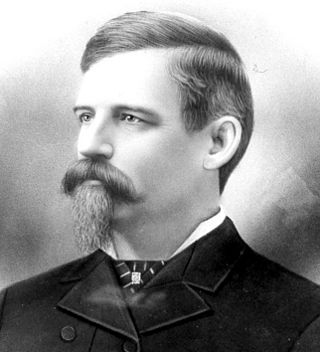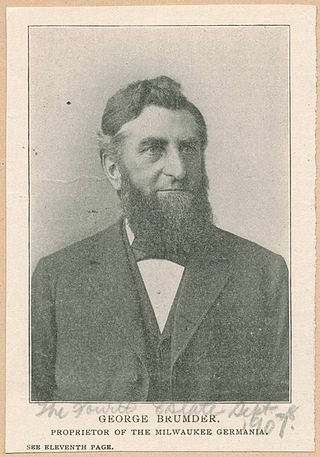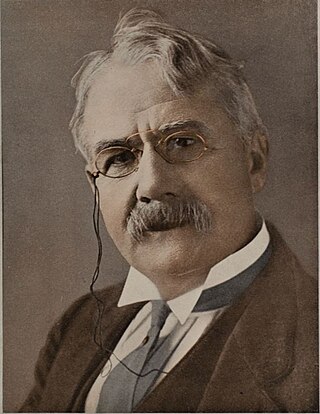
Frank Abial Flower (1854–1910) was an editor at various newspapers, an author, and government official. He wrote many history books, several related to Wisconsin and leading Republicans of his era.

Frank Abial Flower (1854–1910) was an editor at various newspapers, an author, and government official. He wrote many history books, several related to Wisconsin and leading Republicans of his era.
Frank A. Flowers was born May 11, 1854, in Cottage in Cattaraugus County, New York. [1] [2]
Flower's journalism career included being a traveling correspondent for Fredonia, New York Advertiser. [2] He was the joint editor of the Milwaukee Evening Chronicle from September to December 1880 and the editor of the Superior Leader from 1891 to 1895. [3]
Flower was the city statistician for Superior, Wisconsin. [4] He worked for the State of Wisconsin as the State Labor Statistician and later became the Chief Statistician. [2] From 1883 to 1887, he was the first Wisconsin Labor Commissioner. [5] In 1899, he was appointed Chief of the Agricultural Division of the Census. [6]
In 1895, Flower was the Executive Secretary for the International Deep Waterways Association, championing the improvement of cargo ship traffic from the Great Lakes with New York City. Flower said, "New-York may not want us to come down to tidewater with our unbroken cargoes of grain and merchandise, but New-York does not always know what is best for herself." [7] [8]
Booker T. Washington of the Tuskegee Institute wrote to Flower in 1890 about how much it would cost to establish a school modeled after Tuskegee Institute in Liberia noting that several students from Liberia were at the existing school in Alabama. [9] Flower was the civilian attaché with the U.S. Commission to Liberia in 1909, appointed by Secretary of State P. C. Knox because he would "be able to supply considerable information and perhaps a few suggestions, based upon his special study of African affairs". [10] It was intended that Washington also be one of the commissioners. [11] During a follow-up trip in 1910 to Liberia for the U.S. to research border issues, Flower died in October. It took over a month for news to even reach Liberia's capital of Monrovia. [12] [13] [14] [15]
His book on the history of Milwaukee, Wisconsin, was published in 1881. His book on the history of the Republican Party, which started in Wisconsin, was published in 1884. [16] His book Life of Matthew Hale Carpenter about Matthew Hale Carpenter was published by D. Atwood and Company in 1884. His book Old Abe, the Eighth Wisconsin war eagle : a full account of his capture and enlistment, exploits in war and honorable as well as useful career in peace was published by Curran and Bowen in 1885). He also published a book of reminisces related to General Herman Haupt. In 1895 his report on the proceedings of the first meeting of the International Deep Waterways Association was published. His book on Edwin McMasters Stanton was published in 1905. [17] [18]

Wisconsin is a state in the Upper Midwestern region of the United States. It borders Minnesota to the west, Iowa to the southwest, Illinois to the south, Lake Michigan to the east, Michigan to the northeast, and Lake Superior to the north. Wisconsin is the 25th-largest state by land area and the 20th-most populous.

Portage is a city in and the county seat of Columbia County, Wisconsin, United States. The population was 10,581 at the 2020 census, making it the largest city in Columbia County. The city is part of the Madison Metropolitan Statistical Area.

Increase Allen Lapham was an American writer, scientist, and naturalist, whose work focused primarily on the what is now the U.S. state of Wisconsin. He made maps of the area and published numerous books on the archaeology, biology, and geology of the region, and discovered both the Panther Intaglio Effigy Mound and Milwaukee Formation. He founded the Wisconsin Natural History Association, and served as the state's Chief Geologist for two years. He also lobbied Congress and the Smithsonian Institution to establish an agency to predict the weather around the Great Lakes and this became the National Weather Service.

Emil Wallber was a German American lawyer and judge. He was the Mayor of Milwaukee, Wisconsin, at the time of the Bay View massacre and labor strike, and adopted the city's first ordinance on an eight-hour work day.

Emil Seidel was a prominent German-American politician. Seidel was the mayor of Milwaukee from 1910 to 1912. The first Socialist mayor of a major city in the United States, Seidel became the vice presidential candidate for the Socialist Party of America in the 1912 presidential election.

Alfred Peter Swineford was an American journalist and politician who served as the second Governor of District of Alaska. He trained as a printer, worked in Minnesota and Wisconsin before becoming the editor and publisher of the Mining Journal in Marquette, Michigan. From this base he became active in politics and was elected Mayor of Marquette and to a term in the Michigan House of Representatives before his appointment as governor.

The Milwaukee Journal Sentinel is a daily morning broadsheet printed in Milwaukee, Wisconsin, where it is the primary newspaper and also the largest newspaper in the state of Wisconsin, where it is widely read. It was purchased by the Gannett Company in 2016.

Emanuel Lorenz Philipp was an American railroad executive and politician from Wisconsin, who served as the 23rd governor of Wisconsin from 1915 to 1921.

Robert Robinson Taylor was an American architect and educator. Taylor was the first African-American student enrolled at the Massachusetts Institute of Technology (MIT), and the first accredited African-American architect when he graduated in 1892. He was an early and influential member of the Tuskegee Institute faculty.

The Menomonee Valley or Menomonee River Valley is a U-shaped land formation along the southern bend of the Menomonee River in Milwaukee, Wisconsin. Because of its easy access to Lake Michigan and other waterways, the neighborhood has historically been home to the city's stockyards, rendering plants, shipping, and other heavy industry. It was also a primary source of pollution for the river.

The lieutenant governor of Wisconsin is the first person in the line of succession of Wisconsin's executive branch, thus serving as governor in the event of the death, resignation, removal, impeachment, absence from the state, or incapacity due to illness of the governor of Wisconsin. Forty-one individuals have held the office of lieutenant governor since Wisconsin's admission to the Union in 1848, two of whom—Warren Knowles and Jack Olson—have served for non-consecutive terms. The first lieutenant governor was John Holmes, who took office on June 7, 1848. The current lieutenant governor is Sara Rodriguez, who took office on January 3, 2023.
Sewer socialism was an originally pejorative term for the American socialist movement that centered in Milwaukee, Wisconsin, from around 1892 to 1960. The term was coined by Morris Hillquit at the 1932 Milwaukee convention of the Socialist Party of America as a commentary on the Milwaukee socialists and their perpetual boasting about the excellent public sewer system in the city.
Wisconsin State College of Milwaukee was a predecessor institution of the University of Wisconsin–Milwaukee.

Edward Sloman Minor was an American businessman, Republican politician, and Wisconsin pioneer. He served six terms in the United States House of Representatives, representing northeastern Wisconsin (1895–1907). He was also the 7th and 16th mayor of Sturgeon Bay, Wisconsin, represented Door County for seven years in the Wisconsin Legislature, and served as a Union Army cavalry officer during the American Civil War.

Wood Creek is a river in Central New York State that flows westward from the city of Rome, New York to Oneida Lake. Its waters flow ultimately to Lake Ontario, which is the easternmost of the five Great Lakes. Wood Creek is less than 20 miles (32 km) long, but has great historical importance. Wood Creek was a crucial, fragile link in the main 18th and early 19th century waterway connecting the Atlantic seaboard of North America and its interior beyond the Appalachian Mountains. This waterway ran upstream from the Hudson River along the Mohawk River. Near present day Rome, the Mohawk River is about one mile from Wood Creek across dry land. In the 18th century, cargo and boats were portaged between the Mohawk and Wood Creek; the crossing was called the "Oneida Carry". In 1797, the Rome Canal was completed and finally established an all-water route. The waterway then followed a downstream run along Wood Creek to the east end of Oneida Lake. After a 20 mile crossing to the west end of the lake, the waterway entered the Oswego River system. This system led either to the Lake Ontario port at Oswego, or further westward along the Seneca River.

George Brumder was a German-American newspaper publisher and businessman in Milwaukee, Wisconsin. Born in Breuschwickersheim, Bas-Rhin, France, Brumder emigrated to the United States, settling in Milwaukee, where he established the largest publishing company of German-American materials in the United States.

Frank Lebby Stanton, frequently credited as Frank L. Stanton, Frank Stanton or F. L. Stanton, was an American lyricist.

Charles Edward Estabrook was an American educator, lawyer, eugenicist, and Republican politician from the U.S. state of Wisconsin. He was the 14th Attorney General of Wisconsin and served 14 years in the Wisconsin State Assembly, representing first Manitowoc and later Milwaukee. As a young man, he was an enlisted volunteer in the Union Army during the American Civil War. Later, he founded the Wisconsin Historical Commission and published several volumes of history of the Civil War for the Wisconsin Historical Society.

The Social-Democratic Party of Wisconsin (SDPW) was established in 1897 as the Wisconsin state affiliate of the Chicago faction of the Social Democratic Party of America. When that organization merged in 1901 to form a political party known as the Socialist Party of America, the Social-Democratic Party of Wisconsin became the state affiliate of that organization, retaining its original name.

Zedekiah Silloway Stanton was an attorney and judge who served as the 44th lieutenant governor of Vermont from 1902 to 1904.